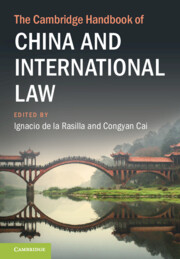Book contents
- The Cambridge Handbook of China and International Law
- The Cambridge Handbook of China and International Law
- Copyright page
- Contents
- Figures
- Contributors
- Foreword
- Acknowledgements
- Abbreviations
- Introduction
- Part I Taking Centre Stage in Global Governance and the International Legal Order
- Part II Interfaces between National and International Law
- Part III Selected Areas of Chinese State Practice
- Part IV International Peace and Security
- Part V Human-Centred International Law
- Part VI The Habitat and the Global Commons
- 16 China and International Environmental Law
- 17 China and Global Climate Change Governance
- 18 China and the Law of the Sea
- 19 China and the Non-weaponization of Outer Space
- Part VII International Economic Law
- Part VIII International Dispute Settlement
- Index
18 - China and the Law of the Sea
from Part VI - The Habitat and the Global Commons
Published online by Cambridge University Press: 04 January 2024
- The Cambridge Handbook of China and International Law
- The Cambridge Handbook of China and International Law
- Copyright page
- Contents
- Figures
- Contributors
- Foreword
- Acknowledgements
- Abbreviations
- Introduction
- Part I Taking Centre Stage in Global Governance and the International Legal Order
- Part II Interfaces between National and International Law
- Part III Selected Areas of Chinese State Practice
- Part IV International Peace and Security
- Part V Human-Centred International Law
- Part VI The Habitat and the Global Commons
- 16 China and International Environmental Law
- 17 China and Global Climate Change Governance
- 18 China and the Law of the Sea
- 19 China and the Non-weaponization of Outer Space
- Part VII International Economic Law
- Part VIII International Dispute Settlement
- Index
Summary
The law of the sea is developed from centuries of national practices; China’s practice has also played a role in that process. International law was introduced into China in the late Qing dynasty. After the Opium War in 1840, the Qing dynasty government had to learn and accept international law, including the law of the sea, as created by the Western countries in order to negotiate and communicate with them. From 1840 until the establishment of the People’s Republic of China in 1949, there were some practices in applying the law of the sea in China focussing on territorial sovereignty and fisheries interests. In the 1970s, the Chinese delegation participated fully in UNCLOS III, ushering in a new era in the practice of the law of the sea. China has made important contributions to the formulation of UNCLOS. It has actively implemented the law of the sea through domestic practices including legislation, law enforcement and judiciary, as well as bilateral consultations and cooperation on law of the sea issues with its maritime neighbours. China is committed to upholding the maritime order with the United Nations at its core and based on international law.
Keywords
- Type
- Chapter
- Information
- The Cambridge Handbook of China and International Law , pp. 358 - 378Publisher: Cambridge University PressPrint publication year: 2024

